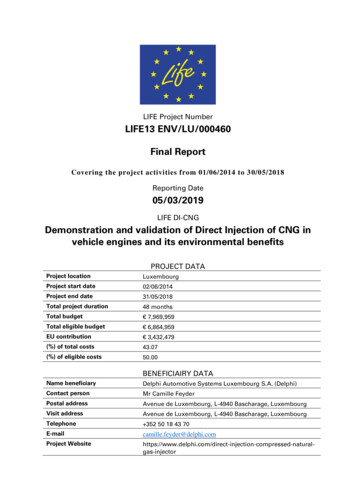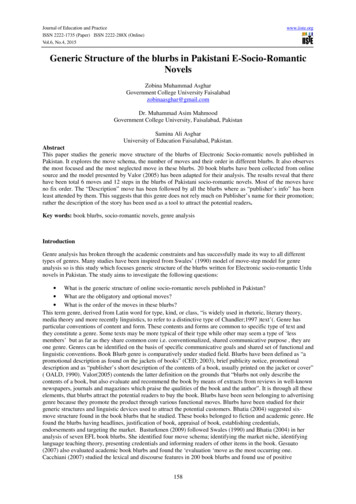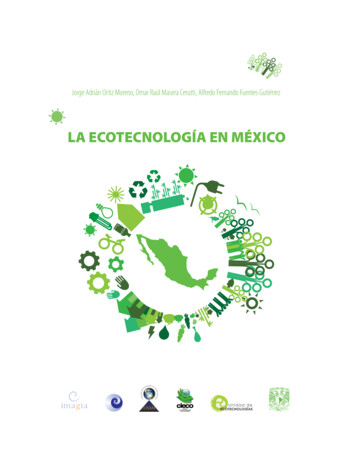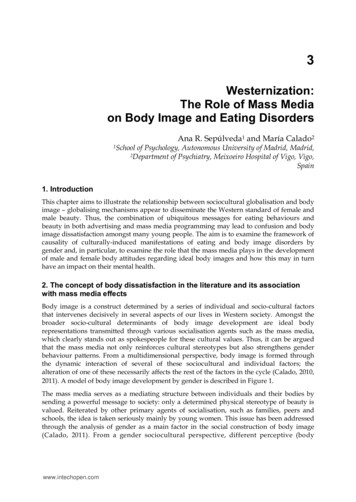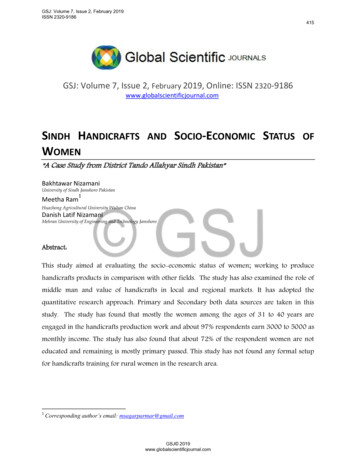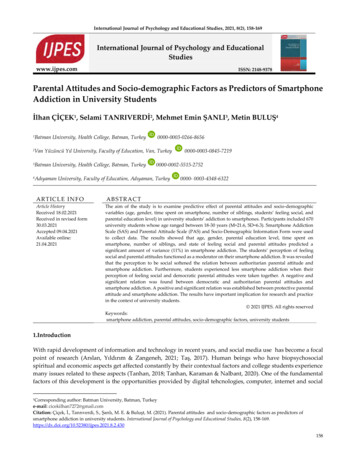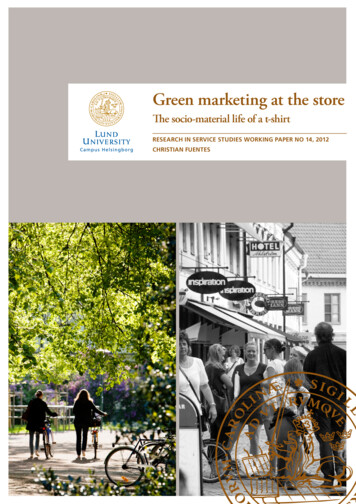
Transcription
Green marketing at the storeThe socio-material life of a t-shirtRESEARCH IN SERVICE STUDIES WORKING PAPER NO 14, 2012CHRISTIAN FUENTES
1
Green marketing at the storeThe socio-material life of a t-shirtChristian Fuentes2
AbstractGreen products are becoming part of contemporary consumer cultures andpart of everyday life. But how are green products constructed? And how dothey work? This paper is concerned with the role that marketing plays in themaking and circulation of green products. My aim is to illuminate the processof green making. Departing from an understanding of marketing as sociomaterial practice I analyse how a green outdoor product - a t-shirt - wasconstructed as green through the marketing practices of the Nordic NatureShops. Focusing on this retail corporation and examining the practices of trailmaking, attending and selling I suggest that these t-shirts become greenthrough a process of socio-material inscription. Through marketing practicesgreen moral is generated and linked to the t-shirts giving and potentiallymaking them desirable consumption objects to be used in the constructionof consumers green identities. But, this process of green making is, I argue, adifficult accomplishment with ambiguous outcomes. The greening ofconsumer culture is not an easy accomplishment and commercial greeningmight also have a number of negative societal consequences.3
IntroductionGreen marketing literature focuses for the most part on understanding howto accomplish the marketing of green products in an efficient and profitablemanner (see also Kilbourne 1998; Meriläinen, Moisander et al. 2000;Ählström, Macquet et al. 2009). Attention is primarily devoted tounderstanding who the green consumer is (e.g. Burke, Millberg et al. 1993;McEachern and McClean 2002; Baker, Thompson et al. 2004; Dickson 2005),how green consumers make purchase decisions (e.g. Carrigan and Attalla2001; Harper and Makatouni 2002; Schröder and McEachern 2004), how tocommunicate with this segment (e.g. Banerjee, Gulas et al. 1995; Zinkhanand Carlson 1995; Charter and Polonsky 1999; Peattie 2002) and if and howto develop green marketing strategies and programmes (Grove, Fisk et al.1996; Wong, Turner et al. 1996; e.g. Charter and Polonsky 1999; Peattie2002; Nair and Menon 2008; for an overview of green marketing reserachsee Chamorro, Rubio et al. 2009). For the most part these studies producehighly abstracted, linear and rational accounts of green marketing and greenconsumption. The work of circulating green products is depicted as amanageable and straightforward matter. To promote green products, tomake them part of everyday life, companies need only to find and categorizegreen consumers, develop offering that will fit this segments andcommunicate the benefits of the green products effectively. In this literature,green marketing is simply a matter of adapting traditional marketing toenvironmental issues.Although very useful from a managerial point of view, what thisresearch misses is the social, cultural and material complexity involved in boththe marketing and consumption of green products. As culturally inclinedconsumer research and critical marketing studies have shown (see Arnouldand Thompson 2005; Tadajewski and Maclaran 2009 for overviews of thesefields) marketing (like consumption) is socio-cultural. Products are consumednot simply to accomplish certain tasks but to maintain certain ways of lives.Products are part of consumers identity projects (Featherstone 1991;Goulding, Shankar et al. 2002), they can enable the participation in certainconsumption collectives (Schouten and McAlexander 1995), be statusmarkers (Holt 1997; Holt 1998) and much more. And marketing practices domore than promote products and make these available to consumers. Incontemporary consumer culture, marketing entails more than finding asegment and communicating the benefits of one’s products. Marketing,research has shown, involves making products meaningful to consumers4
through different means and in different ways (e.g. Peñaloza 1999;Thompson 2004; Svensson 2007; Fuentes 2011).Against this background, one can ask, how are green productsconstructed as meaningful consumption objects by marketing practices?What kind of green products are constructed? And, what happens as thesegreen products are constructed?While socio-cultural studies of green consumption have clearly shownthat green products are used as symbolic resources in the construction ofconsumer identities (Cherrier 2006; Cherrier and Murray 2007; Connolly andProthero 2008), the formation of consumption communities (Cherrier andMurray 2002; Moisander and Pesonen 2002; Jonsson 2006; Thompson andCoskuner-Balli 2007; Thompson and Coskuner-Balli 2007) and theproduction of consumption experiences (Soper 2007; Thompson andCoskuner-Balli 2007; Thompson and Coskuner-Balli 2007) there are to datefew studies that explore how marketing constructs green products asmeaningful material-symbolic artefacts. This is the gap I want to addresshere. My contention is that marketing green products involves making theseproducts meaningful for consumers (see also Prothero and Fitchett 2000;Connolly and Prothero 2003). It involves constructing material-symbolicartefacts that make sense to consumers and fit into their lives and theirpractices.The aim of this paper is to contribute a socio-cultural and criticalunderstanding of green marketing by exploring and illustrating howmarketing practices work to construct green products as meaningfulmaterial-symbolic artefacts in practice. Understanding this, I suggest, isimportant if we are to understand how green marketing works incontemporary consumer culture.In the sections that follow I do mainly three things to accomplish thistask. First, I sketch out a socio-material practice perspective. To understandhow marketing practices work to make green products one must have aperspective that acknowledges the social, cultural and material character ofmarketing. efactsseriously.Drawing on a specific strand of practice theory I will develop an approachthat acknowledges the socio-material aspects of practice. As I explain inmore detail in the next section, from this perspective practices always bothinvolve and simultaneously transform a range of material artefacts. Practicesare thus not only social and cultural but also material.Second, using this specific practice framework, I analyse how one greenproducts – the Save the Artic Fox t-shirt - is marketed at the Nordic Nature5
Shop – a Swedish chain of outdoors clothing and equipment retailers. Thisspecific case serves as an example of green marketing. What I offer is anempirically based and theoretically informed reading of how the marketingpractices carried out at the Nordic Nature Shop outlets construct greenproducts. The argument developed will be that green products are madegreen by being inscribed with a certain environmental morality. I will showhow the Save the Artic Fox is, through the marketing practices of displaying,attending and selling, constructed as specific type of material-symbolicartefacts.Third, I discuss some of the implications of this perspective. That is, Idiscuss what it might mean to start thinking of green products as materialsymbolic artefacts made in and through marketing practices.Socio-material practicesIt is becoming increasingly common across the Social Sciences to think interms of practices (Schatzki, Cetina et al. 2001; Reckwitz 2002). PracticeTheory - as this loosely interconnected school of through is sometimes called- has been discussed and used within a number of fields. Theories of practiceare, for example, used in organization studies (Orr 1996; Schatzki 2006;Miettinen, Samra-Fredricks et al. 2009), strategy research (Whittington 2006)consumption studies (Shove and Pantzar 2005; Warde 2005; Schau, Jr. et al.2009), design studies (Ingram, Shove et al. 2007; Shove, Watson et al. 2007),marketing studies (Araujo 2007; Andersson, Aspenberg et al. 2008), andmany other fields. With this dispersion comes also diversity. There is today nounified practice approach. Instead one can find a range of differentapproaches that go under this label (Schatzki 2001).Despite the many differences practice theories have some things incommon. Practice advocates argue that the social consists of nexus ofpractices and that it is within these practices that social life is organized,reproduced, and transformed (Schatzki, Cetina et al. 2001). Accordingly,practice scholars contend that the field of practice is the appropriate place tostudy issues as diverse as meaning, agency, ethics and power (Schatzki,Cetina et al. 2001). But what, exactly, are practices? Following Reckwitz wecan say that a practice is:“a routinized type of behaviour which consists of severalelements interconnected to one another: forms of bodilyactivities, forms of mental activities, “things” and their use, a6
background knowledge in the form of understanding, knowhow, states of emotions and motivational knowledge”(Reckwitz2002: 250)Common for all practice approach is a focus on the doings as well as sayings.Practice approaches differ then from discursive analysis in that they look atmore than language and text and they are also different fromphenomenological approaches in they are interested in more than minds(Reckwitz 2002). Practices are “temporally unfolding and spatially dispersednexus of doings and sayings” (Schatzki 1996: 89), they are ways of moving,handling objects and understanding the world. Practices are social in thesense that they are ways of thinking and acting that appear in different timespace and are carried out by different individuals (Reckwitz 2002). Theindividual is here “only” an enactor of practice and the meeting point formultiple practices (Reckwitz 2002).Although most practice theorist would agree that practices involve bothhuman and non-humans elements the role that these elements are assigneddivides practice theorists. For the most part practice theorists are viewpractices as (purely) human practices. These scholars focus on the skills,knowledge and understandings involved in practices. For them, materialartefacts are part of practices but have no agency of their own. They aresimply passive tools or background. There is however what Schatzki calls animportant minority of “posthumanists” (Schatzki 2001). Posthumanistpractice approaches, often closely connected to the field of Science andTechnology Studies (STS), draw attention to the presence of non-humanentities in practices arguing that these entities do much more that simplymediate practices (Preda 1999; Schatzki 2001). The non-humans are in theseaccounts considered crucial to the making of social practices. In fact,artefacts are argued to “play an active part in the generation, stabilization,and reproduction of social order” (Preda 1999 : 349). Things (materiality,material artefacts, objects) play a crucial role in the reproduction of socialpractice.It is this second strand of practice theory that interest me here. As theterm socio-material practice indicates, what I formulate is very much amaterialist approach. In formulating a socio-material practice perspective, Imake use of concepts and ideas not only from practice theory but also actornetwork theory (ANT) (e.g. Law and Hassard 1999; Latour 2005). This is nota completely novel approach. Theories of practice and concepts from ANThave previously been combined to study and discuss issues such as marketmaking (Kjellberg and Helgesson 2006; Araujo 2007; Kjellberg and7
Helgesson 2007), the invention and re-invention of consumption practices(Shove and Pantzar 2005), and role of design (Ingram, Shove et al. 2007). Myintention is to continue in this vain by applying a socio-material practiceperspective to green marketing.Practices are, I argue, heterogeneous and performative. Practices areheterogeneous in that they draw on a number of different elements – bothhuman and non-human (Kjellberg and Helgesson 2006). Practices are thensimultaneously social, cultural and material always involving an assembly ofdifferent entities. To think in terms of socio-material practice is then to treatmateriality and its meanings, image and things, humans and non-humanssimultaneously and as intrinsically interlinked.Practices are also performative in that they do not simply make use ofheterogeneous materials but also transform them. Borrowing ideas andconcepts developed within actor-network theory (e.g. Law 1991; Law andHassard 1999; Latour 2005), one can say that practices make assemblages –they interconnect ideas, emotion and understandings with material artifactsand bodies. But the relationship is one of mutual dependency: asassemblages are made they in turn shape practices in different ways.Assemblages then are constructed in practice but they also have the ability toaffect practices – they have agency.The world is, from this perspective, hybrid and performed. Also, thesocio-material practice approach sketched out here is clearly constructionistin that it avoids essentialist accounts. It is, however, different from socialconstruction. In a socio-material practice perspective the world is not onlysocio-culturally constructed but also materially. Social reality is “a materiallyheterogeneous relational effect” realized through on-going practice(Kjellberg and Helgesson 2006: 840).So with this in mind I turn now to the specific issue of marketingpractices. Drawing on the socio-material practice perspective developedabove, I make three claims. First, I claim that marketing can be fruitfullyunderstood as a set of practices aimed at facilitating exchange (Araujo 2007).Their goal is to circulate products. They do this, however, in numerous ways.They do this by, for example, relating product design to product use, byembedding, if you will, products in specific contexts (Araujo 2007). Butmarketing practices also attempt to facilitate exchange for specific products,services and corporations by constructing attractive brands, segmentingmarkets, distributing products and so on. Second, I argue that marketingpractices are heterogeneous. Marketing is heterogeneous involving a rangeof different human and non-human elements. More than that, marketinginvolves hybrid actors – heterogeneous assemblages that “do” marketing in8
different ways. Third, I argue that marketing practices are performative(Araujo 2007) – they do not only act in the world but actively constructs it(Fuentes 2011). Thus, the marketing of any product involves a range ofdifferent elements – knowledge, artifacts, a specific understanding of theworld and so on - but it also transforms these elements. From thisperspective the marketing of products is thus unavoidably also thetransformation of products.Shadowing a t-shirt: an ethnographic studyAt the time of writing, the Nordic Nature Shop chain consists of 27 stores,located both in larger and smaller cities across Sweden. The stores are almostexclusively to be found at city centres. They are often well organized anddecorated in accordance with the “nature” theme. The products marketedinclude backpacks, sleeping bags, camping tents, hiking boots, sandals,jackets, t-shirts, stoves, cooking gear and various books. The Save the ArticFox t-shirts are among the most visibly “green” products at the NordicNature Shop outlets. The stores serves here as an example of how greenproducts are constructed and what happens as they are constructed.As is often the case in ethnographic studies, the material analysed wasproduced through a combination of different data collecting techniques(Arnould and Wallendorf 1994; Hammersley and Atkinson 2007).I carried out approximately 80 observations during a period of 40months. I begun the fieldwork in April 2006 and carried out the lastobservation in August 2010. Of these observations 70 were carried out at 13different Nordic Nature Shop outlets and 10 at other outdoors and sportsstores. The stores were located both in smaller and larger cities in Sweden.The observations were thus spatially and temporally dispersed coveringdifferent times of the day and different seasons as well as different locales.The observations lasted between 10 to 45 minutes and field notes wherewritten within a day, usually directly after a session to produce as muchdetail as possible (see Emerson, Fretz et al. 1995 on the importance ofwritting fieldnotes). During my visits to the stores I also collected marketingmaterial available and took photographs of the stores and display windows.I also conducted ethnographic interviews (Spradley 1979; Holt 1997)with consumers and company staff. To get an idea of how outdoorspractitioners enacted their worlds I carried out 12 interviews with 12outdoors practitioners that also shopped at the Nordic Nature Shop. The9
consumers differed in terms of gender, age, and educational background,occupations and outdoors interest. The interviews lasted between 45 to 90minutes and revolved around three broad themes: their outdoor practicesand the role that products played in them, the Nordic Nature Shop and theoutdoors world more generally. Informants were encouraged to talk in detailabout their outdoor practices, the products they had, how these productsworked and were they were bought and why as well as talk more freelyabout nature and the outdoors world. The interviews were transcribed in full.In addition, to get a better understanding of those working at the NordicNature Shop and how they co-produced the outdoors world I also carried outinterview with store assistants. I interviewed two store assistants about theirwork and also their outdoors practices. These interviews were lasted about50 minutes in length and were also transcribed in full.Finally, I have also carried out what I refer to as “collecting” – that is,the gathering of different artefacts available and deemed relevant for closerfor analysis. I used mainly three different collecting techniques. First, Icollected different artefacts while doing observations– collecting, forexample, catalogues, brochures, tags, and products from the stores. Second,I also collected texts using the Internet. I used this form of virtual collectingto get hold of company documents, reports on the outdoors industry,marketing material, newspaper articles (using web based databases) and tostudy the webpage’s of outdoors companies. Finally, I also collected“regular” newspaper clippings from both magazines such as Outside and“Utemagasinet” (Sweden’s largest outdoors magazine) and they day press.Together these research practices produce the materials that make upthe empirical database used in the analysis. One can say that I “shadowed”(Czarniawska 2007) the Save the Artic Fox t-shirts in two different ways andat two different times. First, I followed them as they were moved throughthe stores when carrying out my observations. Later on, when conductingthe analysis, I followed them through the material, searching the fieldnotes,interview transcripts, photographs, documents and products in order toexamine what happened to these t-shirts as they moved from practice topractice within the stores. The analysis was guided by three overarchingquestions: what kinds of practices are carried out here? How do thesepractices work to green this outdoors products? And how can the greenproducts made transform consumption practices?In what follows I describe the marketing practices carried out at thestores and their results. I use field notes and interview extracts incombination to illustrate the practices.10
Greening t-shirtsSo, how are green products made in practice? To investigate this question Iexamine the Nordic Nature Shop and the marketing of the Save the Artic FoxT-shirts. The practices discussed will be recognizable to those familiar withthe world of retailing. To be clear, my ambition is not to “discover” newmarketing practices. Nor am I saying that these marketing practices arespecific to green marketing. Instead what I want to do is to examine howthese common marketing practices worked to construct green products.Showing the t-shirts: inscribing green productsI entered the Nordic Nature Shop outlet and took a lookaround. The décor was dark green in color. The walls, some ofthe racks and the cashier counter were all made of wood. Therewere also some benches made out of log and surrounded byplastic grass. Somewhat surprised I realized I could hear birdssinging. The sound, I soon found out, was coming out of smallspeakers cleverly positioned throughout the store. As Iexamined the décor more closely I also noticed that there wereseveral stuffed reindeer heads mounted on the walls.I continued into the store. Almost immediately I fell into to therhythm of the other shoppers. Guided by the trails I browsedthrough products, looking, touching and even smelling them attimes. I picked up products, examined them and put them backafter a quick look. I read brochures that were laid out andlooked at posters. It was all rather pleasant and I soon I feltcomfortable enough to start trying out products.I was looking to try out a Save the Save Artic t-shirt. I had seenthe t-shirts during a previous visit to the store and was nowcontemplating buying one. Sure enough I found a similardisplaying table where the t-shirts were stacked. I walked overto the table and started going over the t-shirts looking for my11
size. I found a t-shirt size medium and headed for the dressingroom (Field notes, 2007-05-14).First, and perhaps most importantly, the Save the Artic Fox t-shirts weremade green through the marketing practices of trail making. By trail makingpractices I refer to a set of marketing practices performed by store assistantsaimed at constructing a trail for consumers. The aim of trail making was toorganize products and store space in a way that facilitated exchange. Theunderlying idea is simple: to make the products visible and available forbrowsing. The products were unpacked, labeled and arranged by store assistantson a daily basis. T-shirts were folded and put on display tables, jackets wereput on rails, GPS devices were placed in display cupboard and hiking bootswere mounted on shelves. The products were organized according todifferent logics. Some products were organized according to productcategory. One could for example often find an entire section of the NordicNature Shop outlets devoted to backpacks. Other products were insteadorganized around an activity, brand or intended user.Through the practices of trail making a number of materials wereinterlinked. The decorative elements, products, display arrangements, posterand signs were interlinked constructing a socio-material assemblagedesigned to facilitate exchange. This socio-material assemblage facilitatedexchange by being both informative and enjoyable – it enabled consumers tofind their products but also put these products into a context. That is, likemany other contemporary retailing spaces the Nordic Nature Shop outletsperformed a multitude of social, cultural and economic tasks in order tomarket their products (see for example Sherry 1998; Peñaloza 1999;Gottdiener 2000; Kozinets, Sherry et al. 2002). Informants talked about the“atmosphere” of the Nordic Nature Shop outlets and seemed to enjoy andappreciate both the more “experiential” aspects of this shopping space andthe fact that the Nordic Nature Shop had a broad assortment of outdoorproducts and information.You get a special feeling when go in [to the Nordic Nature Shopoutlet]. You get an outdoors feeling I don’t know exactlywhat we bought there but we sure visited the stores a lot(interview with David).In this interview extract it becomes clear that the stores were appreciated formore than their assortment of quality products.12
It is then within this enjoyable and informative retailing space that theSave the Artic Fox t-shirts were put on display. And it is through the practicesof trail making that these t-shirts were constructed as green. The Save theArtic Fox display arrangement could be found in most of the Nordic NatureShop outlets. They were often similar in terms of design and location.Normally, a display table made of wood and dark green in colour was placedclose to the cash register. On this display table stores assistants would foldtwo stacks of t-shirts according to colour. In one stack there would be the tshirts in the colour “olive”, in the other those in “graphite”. A sign explainingthe Save the Artic Fox project was placed behind the t-shirts. On the sign,which consisted of a plastic frame and a sheet of paper with letters in blackfont printed on it, consumers could read:Save the Swedish Artic Fox! The Swedish Artic fox has longbeen threatened by extinction but now the situation is worsethan ever. New genetic analyses conducted by the ZoologicalDepartment at Stockholm University shows that the Artic foxpopulation has slowly but surely genetically deteriorated.SEFALO is a Swedish – Finish - Norwegian cooperation projectand the Nordic Nature Shop and the outdoor companyFjällräven have join together to provide economic support toSEFALO s work. For each t-shirts sold 50 Crowns are donated tothe project. (Text from Nordic Nature Shop website 2007-0605,).This artefact was one of the most visible actants of the arrangements andgave them an informative character. The signs clearly signalled that therewas information to consider when purchasing these t-shirts.Of course, the signs were not the only communicative actant of thedisplay arrangements. On the chest and sleeve of the t-shirts the text “Savethe Artic Fox” was printed in large letters accompanied by the image of awhite fox contrasting against the green (or grey) background. The brand –Fjällräven – and its signature red logo depicting a fox were placed on thesleeve, on the chest and inside the t-shirts.A paper tag was also attached to each t-shirt. On these tags theFjällräven brand and red logo figured no less than three times accompaniedby the address to the Fjällräven webpage and information about price, sizeand colour of the t-shirts. Also, the word “Travel” and an image of a caravanof camels walking in the dessert figured on the t-shirt indicating that thisitem was part of the Fjällräven “Travel” concept. The travel concept is one of13
five concepts that Fjällräven uses to categorise their products. On the tagsconsumers could read:Travel means adventure no matter if you go to the archipelagoof Stockholm or the rain forests of Amazons. Our Travelproducts will simplify your adventure and you will always beable to put your trust in them. The result of our productdevelopment gives you UV protection, multipurpose function,low weight, fast drying and easy care products (Tag on the Savethe Artic Fox t-shirt).What I am describing is the construction of socio-technical assemblages.Through the marketing practices of trail making a specific arrangement ofartefacts and ideas were interconnected to perform a specific marketing task.Together the display table, t-shirts, sign and tags worked to show consumersthat the Save the Artic Fox t-shirts were desirable products. Theseassemblages communicated a particular message with the aim of attractingconsumers. And indeed, they seemed successful. At the Nordic Nature Shopoutlets one could observe a stream of consumers passing by thesearrangements at different hours of the day. Some consumers only glanced atthem before moving on, others approached to get a closer look. Some onlyshowed interest in the t-shirts, others read the sign carefully and withapparent interest. A few, attracted by the t-shirts design, the message on thesigns or a combination of the two, interacted with the t-shirts. The t-shirtswere then carefully examined. Consumers touched the material and checkedthe tags. In some instances the t-shirts were carried away to fitting roomsand tried on.But how were the products constructed as green? My argument is thatgreen products were made green by inscribing them with specific moralities.That is, these products were, through socio-material marketing practices,connected to a specific set of understandings and ideas of right of wrong. Inarguing this I am drawing on specific notion of morality, or rather moralities,as materialized. As Jelsma so eloquently puts it:this socio-technical landscape is also a moral landscape. Itreflects the collective notions of the good life. As a result ofearlier inscriptions, the scripted materiality of the landscapecreates all kind of gradients for behaviour, encouraging andrewarding what is acceptable, desirable and comfortable while14
counteracting what is strenuous, contemptible and forbidden.(Jelsma 2003: 107)So, artefacts are moral. I will show how the marketing practices of the NordicNature Shop inscribe (Akrich 2000) the Save the Artic Fox t-shirt with aspecific morality. In the practices of trail making green moralities wereproduced, or rather materialized, in the connections made between differentactants. The key actant in the construction of moral was the sign displayingthe SEFALO project text. Drawing on a scientific discourse this text arguedthat the Artic Fox is in great danger. It made clear that there was a pressingneed to take action. The environment should be preserved and it should bepreserved through consumption. The t-shirts on display also promoted thismessage. The text written on the chest “Save the Artic Fox” connected toand supported the text on the sign. In the same way, the soft texture andgrey and green colours of the t-shirts, as well as the dark green colour andwood material of the display tables came together to collectively produce this“green” message. That is, the different actants were configured to producethis specific message. But what kind of message was it?When interconnected in practi
making, attending and selling I suggest that these t-shirts become green through a process of socio-material inscription. Through marketing practices green moral is generated and linked to the t-shirts giving and potentially making them desirable consumption objects to b

